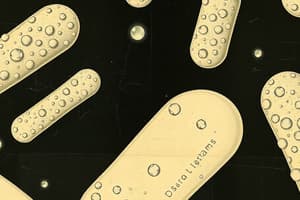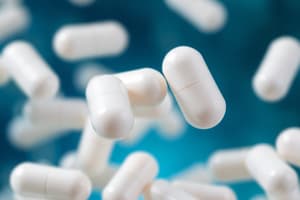Podcast
Questions and Answers
A patient with a known penicillin allergy requires antibiotic treatment for a severe infection. Given the cross-reactivity between penicillin and cephalosporins, which of the following approaches would be MOST appropriate?
A patient with a known penicillin allergy requires antibiotic treatment for a severe infection. Given the cross-reactivity between penicillin and cephalosporins, which of the following approaches would be MOST appropriate?
- Initiate antimicrobial desensitization with a cephalosporin under controlled conditions. (correct)
- Administer a third-generation cephalosporin with close monitoring for immediate hypersensitivity reactions.
- Administer a high dose of a first-generation cephalosporin to overwhelm any potential allergic reaction.
- Avoid cephalosporins altogether and choose an antibiotic from a different class, regardless of its efficacy against the suspected pathogen.
A patient develops antibiotic-induced seizures during treatment for a complicated urinary tract infection. What is the MOST appropriate initial intervention?
A patient develops antibiotic-induced seizures during treatment for a complicated urinary tract infection. What is the MOST appropriate initial intervention?
- Immediately discontinue all antibiotics and monitor neurological status without intervention.
- Initiate a rapid infusion of intravenous magnesium sulfate to address potential electrolyte imbalances.
- Administer intravenous phenytoin to prevent further seizure activity.
- Administer a benzodiazepine to control the acute seizure. (correct)
A patient is prescribed erythromycin for a respiratory infection. Which of the following factors would MOST significantly increase the risk of QT prolongation?
A patient is prescribed erythromycin for a respiratory infection. Which of the following factors would MOST significantly increase the risk of QT prolongation?
- Concurrent use of amiodarone for atrial fibrillation. (correct)
- Male sex and absence of cardiac disease.
- Normal hepatic function.
- A history of penicillin allergy.
A patient with a severe MRSA infection is being treated with vancomycin. What is the primary mechanism by which vancomycin exerts its antimicrobial effect?
A patient with a severe MRSA infection is being treated with vancomycin. What is the primary mechanism by which vancomycin exerts its antimicrobial effect?
A patient with a history of anaphylaxis to amoxicillin requires treatment for a gram-negative infection. Which of the following beta-lactam/beta-lactamase inhibitor combinations would be MOST appropriate to avoid due to potential cross-reactivity?
A patient with a history of anaphylaxis to amoxicillin requires treatment for a gram-negative infection. Which of the following beta-lactam/beta-lactamase inhibitor combinations would be MOST appropriate to avoid due to potential cross-reactivity?
A patient is diagnosed with a respiratory infection caused by Mycoplasma pneumoniae. Which of the following antibiotics would be MOST appropriate, considering both efficacy and potential for drug interactions?
A patient is diagnosed with a respiratory infection caused by Mycoplasma pneumoniae. Which of the following antibiotics would be MOST appropriate, considering both efficacy and potential for drug interactions?
A patient is receiving intravenous azithromycin for a severe community-acquired pneumonia. Which of the following parameters would be MOST important to monitor closely due to a potential adverse effect of azithromycin?
A patient is receiving intravenous azithromycin for a severe community-acquired pneumonia. Which of the following parameters would be MOST important to monitor closely due to a potential adverse effect of azithromycin?
A patient with a history of multiple hospitalizations and antibiotic use develops a severe pneumonia caused by a multidrug-resistant Gram-negative organism. Which of the following antibiotic combinations would be MOST appropriate, assuming susceptibility testing is pending?
A patient with a history of multiple hospitalizations and antibiotic use develops a severe pneumonia caused by a multidrug-resistant Gram-negative organism. Which of the following antibiotic combinations would be MOST appropriate, assuming susceptibility testing is pending?
A patient receiving vancomycin develops "Red Man Syndrome". What is the MOST appropriate intervention to manage this reaction?
A patient receiving vancomycin develops "Red Man Syndrome". What is the MOST appropriate intervention to manage this reaction?
An immunocompromised patient is diagnosed with vancomycin-resistant Enterococcus (VRE). Which mechanism MOST likely confers this resistance?
An immunocompromised patient is diagnosed with vancomycin-resistant Enterococcus (VRE). Which mechanism MOST likely confers this resistance?
A patient is prescribed daptomycin for a complicated skin infection. Which pre-existing condition would warrant CAUTION when using this medication?
A patient is prescribed daptomycin for a complicated skin infection. Which pre-existing condition would warrant CAUTION when using this medication?
A patient on linezolid for a MRSA infection reports taking an over-the-counter medication daily. Concurrent use of which of the following medications would raise the GREATEST concern for serotonin syndrome?
A patient on linezolid for a MRSA infection reports taking an over-the-counter medication daily. Concurrent use of which of the following medications would raise the GREATEST concern for serotonin syndrome?
A patient with a severe intra-abdominal infection is being treated with tigecycline. After a week, the patient's condition worsens, and cultures reveal a multidrug-resistant organism. What is the MOST important consideration regarding tigecycline use in this scenario?
A patient with a severe intra-abdominal infection is being treated with tigecycline. After a week, the patient's condition worsens, and cultures reveal a multidrug-resistant organism. What is the MOST important consideration regarding tigecycline use in this scenario?
A patient with a history of end-stage renal disease develops a multidrug-resistant Pseudomonas aeruginosa infection. Colistin is being considered as a treatment option. What monitoring parameter is MOST critical during colistin therapy to prevent irreversible complications?
A patient with a history of end-stage renal disease develops a multidrug-resistant Pseudomonas aeruginosa infection. Colistin is being considered as a treatment option. What monitoring parameter is MOST critical during colistin therapy to prevent irreversible complications?
A patient receiving gentamicin for a gram-negative infection has fluctuating drug levels despite consistent dosing. To optimize efficacy and minimize toxicity, which dosing strategy is MOST appropriate?
A patient receiving gentamicin for a gram-negative infection has fluctuating drug levels despite consistent dosing. To optimize efficacy and minimize toxicity, which dosing strategy is MOST appropriate?
A young adult female is prescribed doxycycline for Lyme disease. What potential adverse effect should the patient be counseled about?
A young adult female is prescribed doxycycline for Lyme disease. What potential adverse effect should the patient be counseled about?
A patient with a history of recurrent urinary tract infections (UTIs) is prescribed trimethoprim-sulfamethoxazole (TMP-SMX). Which potential electrolyte imbalance warrants careful monitoring in this patient?
A patient with a history of recurrent urinary tract infections (UTIs) is prescribed trimethoprim-sulfamethoxazole (TMP-SMX). Which potential electrolyte imbalance warrants careful monitoring in this patient?
A patient is prescribed metronidazole for Clostridium difficile infection. Which of the following instructions is MOST critical to provide to the patient regarding potential drug interactions?
A patient is prescribed metronidazole for Clostridium difficile infection. Which of the following instructions is MOST critical to provide to the patient regarding potential drug interactions?
A patient on rifampin for tuberculosis treatment is also taking warfarin for anticoagulation. What potential interaction should clinicians be aware of when prescribing these medications concomitantly?
A patient on rifampin for tuberculosis treatment is also taking warfarin for anticoagulation. What potential interaction should clinicians be aware of when prescribing these medications concomitantly?
A patient is prescribed clindamycin for a skin infection. What is the MOST important counseling point to emphasize to the patient regarding potential adverse effects?
A patient is prescribed clindamycin for a skin infection. What is the MOST important counseling point to emphasize to the patient regarding potential adverse effects?
A healthy young woman is diagnosed with an uncomplicated urinary tract infection (UTI). Which of the following oral antibiotics would provide the MOST targeted approach for this patient regarding antimicrobial spectrum and safety?
A healthy young woman is diagnosed with an uncomplicated urinary tract infection (UTI). Which of the following oral antibiotics would provide the MOST targeted approach for this patient regarding antimicrobial spectrum and safety?
A patient with a severe penicillin allergy requires treatment for a gram-positive infection. Which of the following beta-lactam antibiotics would be the SAFEST option to consider, IF ANY, in this patient?
A patient with a severe penicillin allergy requires treatment for a gram-positive infection. Which of the following beta-lactam antibiotics would be the SAFEST option to consider, IF ANY, in this patient?
Which property is the MOST important determinant of efficacy for beta-lactam antibiotics?
Which property is the MOST important determinant of efficacy for beta-lactam antibiotics?
Flashcards
β-lactam MOA
β-lactam MOA
Inhibit cell wall synthesis by binding to penicillin-binding proteins (PBPs) and preventing transpeptidation.
β-lactam Bactericidal/Bacteriostatic?
β-lactam Bactericidal/Bacteriostatic?
Bactericidal, except against enterococcus species.
β-lactam Efficacy Determinant
β-lactam Efficacy Determinant
Time above the minimum inhibitory concentration (MIC).
Macrolide MOA
Macrolide MOA
Signup and view all the flashcards
Macrolide with No CYP Interaction
Macrolide with No CYP Interaction
Signup and view all the flashcards
Common Macrolide Uses
Common Macrolide Uses
Signup and view all the flashcards
Major Macrolide Cardiac Side Effect
Major Macrolide Cardiac Side Effect
Signup and view all the flashcards
Antibiotics with Highest QT Prolongation Risk
Antibiotics with Highest QT Prolongation Risk
Signup and view all the flashcards
Vancomycin mechanism
Vancomycin mechanism
Signup and view all the flashcards
Vancomycin resistance
Vancomycin resistance
Signup and view all the flashcards
Red Man Syndrome
Red Man Syndrome
Signup and view all the flashcards
Vancomycin toxicities
Vancomycin toxicities
Signup and view all the flashcards
Daptomycin mechanism
Daptomycin mechanism
Signup and view all the flashcards
Daptomycin and pneumonia
Daptomycin and pneumonia
Signup and view all the flashcards
Daptomycin toxicity
Daptomycin toxicity
Signup and view all the flashcards
Linezolid mechanism
Linezolid mechanism
Signup and view all the flashcards
Linezolid adverse effect
Linezolid adverse effect
Signup and view all the flashcards
Tigecycline mechanism
Tigecycline mechanism
Signup and view all the flashcards
Tigecycline side effects
Tigecycline side effects
Signup and view all the flashcards
Aminoglycosides mechanism
Aminoglycosides mechanism
Signup and view all the flashcards
Aminoglycosides toxicity
Aminoglycosides toxicity
Signup and view all the flashcards
Tetracyclines mechanism
Tetracyclines mechanism
Signup and view all the flashcards
Tetracyclines interactions
Tetracyclines interactions
Signup and view all the flashcards
Study Notes
- β-Lactam antibiotics inhibit bacterial cell wall synthesis by binding to penicillin-binding proteins (PBPs), preventing transpeptidation.
- β-Lactams are bactericidal, except against enterococcus.
- Efficacy of β-lactams depends on the duration of time that the drug concentration remains above the minimum inhibitory concentration (MIC).
- β-Lactams are dosed frequently because they have a short half-life.
- Macrolides bind to the 50S ribosomal subunit, thus inhibiting protein synthesis.
- Azithromycin is the only macrolide that does not interact with CYP enzymes.
- Macrolides are commonly used for respiratory infections, STDs, Mycobacterium avium, and Bordetella infections.
- A major cardiac side effect of macrolides is QT prolongation.
- Erythromycin carries the highest risk of QT prolongation among macrolides.
- Allergic reactions to β-lactams include maculopapular rash, hives, and anaphylaxis.
- β-Lactams are associated with the highest incidence of anaphylaxis among antibiotic classes.
- The estimated cross-reactivity between penicillins and cephalosporins is 1-10%.
- Antimicrobial desensitization is a controlled process used to induce temporary tolerance in allergic patients.
- Benzodiazepines are the first-line treatment for antibiotic-induced seizures.
- Carbapenems and especially imipenem, have the highest seizure risk among antibiotic classes.
- Antibiotics with the highest risk for QT prolongation include macrolides, fluoroquinolones, azole antifungals, and pentamidine.
- Risk factors for antibiotic-induced QT prolongation include female sex, electrolyte abnormalities, cardiac disease, and drug interactions.
- Antibiotics used for multidrug-resistant gram-positive infections include vancomycin, linezolid, daptomycin, and tigecycline.
- Antibiotics used for multidrug-resistant gram-negative infections include colistin, ceftolozane/tazobactam, and ceftazidime/avibactam.
- Vancomycin is primarily used to treat MRSA and serious gram-positive infections.
- Vancomycin inhibits cell wall synthesis by binding to D-Ala-D-Ala in peptidoglycan precursors.
- Vancomycin resistance in enterococci is mediated by the replacement of D-Ala-D-Ala with D-Ala-D-Lac.
- "Red Man Syndrome" involves histamine release that causes flushing and hypotension during rapid vancomycin infusion.
- Red Man Syndrome can be prevented by slowing vancomycin infusion and premedication with antihistamines.
- Major toxicities of vancomycin include nephrotoxicity and ototoxicity.
- Daptomycin disrupts bacterial cell membranes via depolarization.
- Daptomycin is not used for pneumonia because it is inactivated by pulmonary surfactant.
- The major toxicity associated with daptomycin is myopathy and rhabdomyolysis.
- Linezolid binds to the 50S ribosome, inhibiting protein synthesis.
- Linezolid is used for MRSA, VRE, and drug-resistant gram-positive infections.
- A major adverse effect of linezolid is bone marrow suppression, specifically thrombocytopenia.
- Linezolid is a weak MAOI that can increase the risk of serotonin syndrome.
- Tigecycline inhibits protein synthesis by binding to the 30S ribosome.
- Tigecycline is used for complicated skin, intra-abdominal infections, and multidrug-resistant bacterial infections.
- Major side effects of tigecycline include nausea, vomiting, and increased mortality in severe infections.
- Colistin is primarily used for multidrug-resistant gram-negative infections.
- The major toxicities of colistin are nephrotoxicity and neurotoxicity.
- Aminoglycosides bind to the 30S ribosome, inhibiting protein synthesis.
- Aminoglycosides primarily target gram-negative aerobic bacteria.
- Commonly used aminoglycosides include gentamicin, tobramycin, and amikacin.
- Major toxicities of aminoglycosides are nephrotoxicity and ototoxicity.
- Aminoglycosides are typically dosed using extended-interval dosing to optimize peak concentrations.
- Tetracyclines bind to the 30S ribosome, inhibiting protein synthesis.
- Tetracyclines are commonly used for atypical pneumonia, Lyme disease, acne, and MRSA infections.
- Divalent cations such as calcium, magnesium, and iron reduce the absorption of tetracyclines.
- A major side effect of tetracyclines in children is tooth discoloration.
- Demeclocycline, a tetracycline, is used for SIADH.
- Sulfonamides inhibit folic acid synthesis.
- Trimethoprim-sulfamethoxazole (TMP-SMX) is used for UTIs, Pneumocystis pneumonia, MRSA, and Nocardia infections.
- Major side effects of TMP-SMX include hyperkalemia, hemolysis in G6PD deficiency, and Stevens-Johnson syndrome.
- Metronidazole forms free radicals that damage bacterial DNA.
- Metronidazole is used for anaerobic infections, C. difficile, bacterial vaginosis, and trichomoniasis.
- A major side effect of metronidazole is a disulfiram-like reaction with alcohol.
- Rifampin inhibits RNA polymerase.
- Rifampin is a strong inducer of CYP450 enzymes reducing drug efficacy.
- A unique side effect of rifampin is red/orange discoloration of body fluids
- Clindamycin binds to the 50S ribosome, inhibiting protein synthesis.
- A major side effect of clindamycin is an increased risk of C. difficile infection.
- Clindamycin is commonly used for anaerobic infections, MRSA, and toxin suppression in necrotizing fasciitis.
- Fosfomycin inhibits bacterial cell wall synthesis by blocking the MurA enzyme.
- Fosfomycin is primarily used for uncomplicated urinary tract infections.
- Nitrofurantoin damages bacterial DNA.
- Nitrofurantoin is commonly used for uncomplicated lower UTIs.
- Nafcillin, oxacillin, ceftriaxone, and cefoperazone are β-lactam antibiotics that are NOT renally eliminated.
- The most common mechanism of resistance to β-lactams is β-lactamase production.
- The four mechanisms of β-lactam resistance are β-lactamase production, PBP modification, impaired penetration, and efflux pumps.
- β-Lactamase inhibitors help β-lactams by inhibiting β-lactamases that degrade β-lactam antibiotics.
- β-Lactam structure includes a fused thiazolidine and β-lactam ring ("house and garage").
Studying That Suits You
Use AI to generate personalized quizzes and flashcards to suit your learning preferences.




